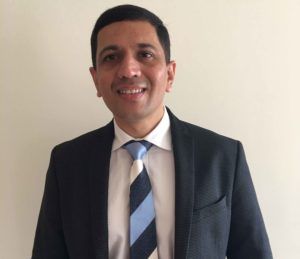Scandent has introduced the latest developments in dental technology in the country for the benefit of the patient and the dentist.

Dr Gautam Deshpande, a Mumbai-based dental surgeon since 2000, and his wife Dr Sowmya, also into clinical dentistry, had gained experience working at different clinics. In 2009, Dr Deshpande branched out to radiology, which was not part of curriculum then or now. Fascinated with the developments in this field, he decided to develop expertise in the latest imaging technologies and introduce them in India.
While in India, the industry was going a transformation in the form of dental chains and expanding clinical practice, other technological developments were transforming the field of radiology globally. Medical CT scan was the commonly used mode of diagnostics covering the head and the neck regions. Cone beam computed tomography (CBCT) was already being used abroad but was as yet not a very familiar technology in India. Seeing the advantages it presented, Dr Deshpande decided to understand it better through research and personal visit to manufacturers as well as markets where it was being used extensively. Finally, in 2012, he introduced this technology through Scandent Imaging in India. “It took us nearly 2.5-3 years to create awareness and make dentists adopt it. Today, the results are encouraging,” explains he.
The USPs
The inherent qualities of this technology have been the focus of the marketing strategy for Scandent. One of the primary advantages of CBCT over Medical CT is the radiation. While the traditional one causes a radiation exposure of 2500 milliseivert, for the same scan, it is only 180-200 in CBCT.
Further, Medical CT is a 2-2.5 minute procedure, where not only is the exposure high, but it also makes the patient feel claustrophobic. CBCT scan, on the hand, is a 15 seconds procedure that can be done with the patient sitting or standing. “Mr Mukesh Ambani, who had come for the scan, was surprised that it got done so fast. His response was like a vindication for us,” reminisces Dr Deshpande.
Cost of a scan too is lower – Rs 1500-3000 as against Rs 6000-9000 for medical CT scan. Quality of the scan is better. The medical CT gives a 1mm slice while it is .75 mm in CBCT, thus providing better insights and improving the diagnostic quality, proving beneficial to the patient as well as the doctor.
Smaller hospitals are unable to grow due to lack of funds. They are looking for partners who will invest and manage their operations.
Building on Strengths
The company, started with self-funding, subsequently issued preferential shares and has cash reserves of Rs 3.8 crores, which is enough to meet its immediate expansion needs. Currently it is present in 11 locations in Mumbai, and more centres are being planned. CBCT is a high-end scanning solution, but Scandent also offers micro imaging (X-Ray and Orthopantogram) through convenience centres for clinics. It operates 100 such centres in Mumbai currently, and will expand within the city as well as other cities in three years, taking the numbers to 500. OPG centres are easy to handle as Scandent needs to only train the local clinical staff in the scanning and manage and maintain as and when needed. Of this, five per cent are expected to become CBCT centres over a period of time.
The company has on board seven oral maxillofacial radiologists trained by Scandent to understand the equipment, the software and its complexities. They in turn train other dental surgeons who refer cases to Scandent to interpret the scan images. The surgeons get the software to enable them to analyse the report. Scandent provides technical support and training as and when needed.
In the last five years, Scandent has also done 25 seminars and workshops.
Going Beyond Imaging
Now Scandent is eyeing other new technologies that can improve the outcome of dental interventions and procedures. One is guided dental surgery, and the other, dental implants.
The guided dental surgery has been developed by Scandent in collaboration with a 3D Post, a group of biomedical engineers, and was introduced in February this year. For dental implants, it has tied up with South Korean DIO Implants to be their partner in the country.
The company is also looking to take over existing small hospitals, upgrade them and grow them. It has already acquired its first 20-bed hospital in Andheri and is in the process of acquiring its second one, a 30-bed hospital, in Mahim. “Smaller hospitals are unable to grow due to lack of funds. They are looking for partners who will invest and manage their operations,” he explains. The company has a six member team to manage this side of the business.
In all, the company has a 22-member team and will expand as needed.

Expanding Reach
Justifying the investment in new technology has been the greatest challenge and could not have been overcome but for support from dental associations and bodies that understood the benefits, acknowledges Dr Deshpande.
The challenge to expansion is the low funding which is forcing the company to be selective and slow. “We haven’t yet sought funding, but in a limited way, we have seen that investors are wary of niche products and solutions,” he opines.
In terms of competition, there isn’t much since the technology has a penetration of 7-8 per cent. But in three to five years, at 25 per cent penetration, the market will heat up. As of now, location and services have been the key reasons for Scandent’s performance. It continues to expect a growth of 100 per cent, and has been experiencing year-on-year growth of 110 per cent. The older centres have started doing well and the newer ones are stabilising, assuring the company of achieving its goals. From a top line of Rs 2 crores last year, it expects to touch Rs 4-5 crores this year.
Dr Deshpande passionately believes that the penetration of OPG in the country is very low and though there are no regulatory hurdles, availability of funding would help private providers like Scandent expand faster and reach out to underserviced areas better.
Snapshot
Venture: Scandent Imaging
Founded in: 2012
By: Dr Gautam Deshpande, Dr Sowmya Deshpande
Focus: Scanning solutions for dentists and ENT
Funded: Equity through preferential issue
Social Media: Scandent introduces new scanning technologies at competitive pricing to improve the quality of diagnostics at a reasonable cost.
Concept
Changing the Face of Dental Imaging
Dr Gautam Deshpande, a dental surgeon in Mumbai, became interested in the developments in radiology in the developed world. To bring those technologies to the country, he personally gained knowledge about them and brought them in through his venture Scandent Imaging in 2012. He worked with dentists closely to create awareness about the cost and quality benefits of these technologies and currently has 11 centres across the city offering these imaging solutions. In the next three years, he intends to grow aggressively and open 100 centres across the country in the next three years. He is also introducing other innovations such as guided dental surgery through an indigenously developed solution and dental implants in association with DIO Implants of South Korea. Scandent is also investing in small hospitals, managing their operations and helping them grow. The company which issued preferential shares may take the debt route to finance its aggressive growth in the next five years.